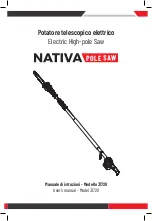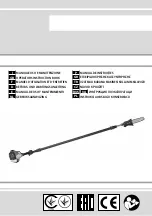
11
.
A new battery or one that has not been used for a long time is gaining full capacity
after about 5 charge and discharge cycles.
The mains voltage must match that indicated on the charger nameplate.
Before starting charging, the condition of the charger and the power cord must always be checked first.
Only the battery charger supplied with the battery must be used to charge the battery
saber saw Put the rechargeable battery in place and until the lock button is clearly clicked
The charger must not be exposed to rain, moisture or liquids.
- Remove the battery from the cordless saber saw.
- Connect the battery to the charger.
-Connects the charger to the mains (230 V).
- Avoid short-term charging one after the other. The battery should not be up to
charges after briefly using the rechargeable battery. During charging, as a charger,
both the battery and the battery are heated. This is perfectly normal. The significant reduction in time between
individual charges indicate that the battery is depleted and needs to be replaced.
7. Cutting
7.1. Install the knife and adjust the guide before starting work.
7.2. Press and release the starter switch to make sure that the power button is off.
7.3. Make sure the blade is away from foreign bodies.
7.4. Ensure that the material to be cut is firmly seated. Small work pieces should be firmly clamped in a vise or attached to a
work table.
7.5. Mark the cutting line.
7.6. To start cutting, grab the saw firmly with both hands and away from you. Approach the front of the guide to the workpiece
that will be cut with a knife placed over the workpiece.
IMPORTANT: Do not start cutting if the blade is in contact with anything before the operation.
7.7. Turn on the tool and wait until the saw reaches the maximum speed before touching the workpiece.
7.8. Pass the saw through the workpiece.
WARNING! Keep the driver firmly pressed against the workpiece while cutting to prevent the tool from getting kicked.
6.9. Allow the saw to stop completely before leaving it anywhere.7
NOTE! Use only as much pressure as you can to trim the detail. Do not force the cutting, allow the blade and saw to do normal
work.
Using excessive pressure that causes the blade to bend or twist may cause it to break.
8. Cutting metal
Metals such as steel, pipes, steel bars, aluminum, brass and copper can be cut with this saw. Be careful not to bend or twist the
blade or to force the cutting action.
We recommend using lubricating oil to lubricate the cutting surface when cutting soft metals and steel. This keeps the blade
cool and prolongs its life.
WARNING! Tighten the workpiece firmly and cut close to the tightening torque to minimize vibration.
When cutting a pipe or bracket, tighten the workpiece in a vise.
To reduce thin sheet metal, place the sheet between a rigid base or plywood and fix the layers to prevent vibration and tearing
of the metal.
9. Maintenance, cleaning, storage
1. Keep the ventilation openings clean and clean at all times to prevent overheating of the engine. Regularly clean the instrument
air vents with compressed dry air.
. Regularly clean the machine case with a soft cloth, preferably after each use. If the dirt is not removed, use a soft cloth
dampened with water and soap. Never use solvents such as gasoline, alcohol, ammonia water, etc. These solvents can damage
the plastic parts.
This machine is designed to run over a long period of time with minimal maintenance. Continuous and satisfactory work
depends on the proper care of the machine and regular cleaning.
. General inspection
1. Check all mounting screws regularly to make sure they are tight.
2. Clean the instrument vents regularly.
Summary of Contents for RD-RS31
Page 68: ...68 www raider bg Exploded drawing of Reciprocating Saw RD RS31 ...
Page 83: ...83 ...
Page 87: ...87 ...












































